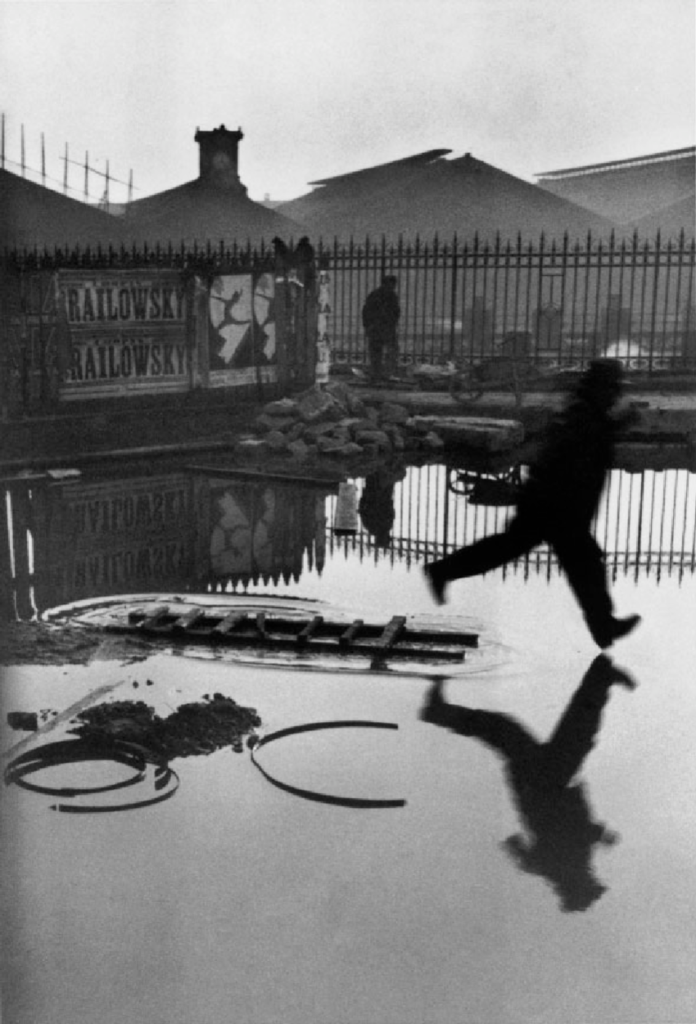Henri Cartier-Bresson is a popular photographer born in 1908, well known for his candid photography. The techniques Cartier developed and used in his own work has since inspired many generations of photographers after him and he is considered to be the father of photojournalism.
Life and Techniques
Henri Cartier grew up in a wealthy family a few kilometres east of Paris. From a young age, he liked to draw and paint, and was even influenced by the Surrealist photography of the 1920s. During his conscription into the French army in 1930, he received his first camera from a friend. Afterwards, Cartier decided to spend a year in the Ivory Coast, where he would learn hunting techniques which he would later use in his photography.
Cartier’s approach to his photography allowed him to make his photos perfect, by using a technique he developed called the ‘Decisive Moment’.
“There is nothing in this world that does not have a decisive moment” – Cardinal de Retz, 17th Century.
This quote perfectly encapsulates Cartier’s technique. From a photographical point of view, the quote can be interpreted as, there is a moment in time where everything aligns perfectly.

Henri Cartier treated photography like hunting. He would align his camera perfectly for a photo and wait for the decisive moment to take the shot. This decisive moment is often when a person wonders into the frame, unaware of the camera.

It is this natural process of allowing the freedom of the world to essentially choose the subject of the photo that gives Henri Cartier’s photos a sense of truthfulness. None of it is faked or staged, Cartier’s work is grounded in reality. And the people in these photos are in their complete natural state, placing another layer of reality onto his photos.
The Leica Rangefinder

The Leica Rangefinder was the primary camera Henri Cartier-Bresson used. The camera was revolutionary for the time. Henri Cartier discovered the camera during his time in the Ivory Coast in 1932. The camera was compact, portable and had a quiet shutter. This was perfect for Henri, the camera could be handheld and kept out of sight, and when he took the photo the sound of the shutter couldn’t be heard by the people around him, allowing Henri to stay completely hidden from the subject and make his photos as true to reality as possible.
Cartier used a 50mm lens. This is because it provided a perspective much like the human eye, and had a wide depth of field, which added another touch of realism to his photos.
Gare Saint-Lazare, Paris, 1932

This is one of Henri Cartier-Bresson’s most popular photos that also outlines some of the techniques that Cartier used in his photography. Firstly, the rule of thirds is applied to the framing of the photo, dividing the photo into three equal parts upwards and three equal parts across.

By framing the photo this way, Cartier divides each detail of the photo into sections, disconnecting every significant detail from each other. This allows for easier viewing, the photo isn’t interconnected and messy, it is organised and direct.
Additionally, the black and white enhance this directness. This is because the photo is stripped of colour, allowing the viewer to interpret just the objects and textures, as the additional complexities of colour are removed from the photo. It is also important to note that the shades of black and white have varying effects on the photo, depending on how dark or light. In the foreground and background of the photo, the people visible are the darkest parts of the photo. Additionally, they are both reflected in the puddle, where both subjects are contrasted heavily by the light of the sky. Both of these features make them stand out in the photo.
These two subjects also demonstrate two techniques Henri Cartier-Bresson used in this photo. The first is that both subjects are in focus, which means that Cartier would have had to use a small aperture so that both subjects and the rest of the photo would be in focus. The second is the connection between the two subjects.

The subject in the foreground is equal size to the subject and his reflection in the background. Although it is not obvious, this creates an invisible lead into the centre and background of the photo.
What is most important about the photo is Henri Cartier-Bresson’s use of the decisive moment. Without Cartier’s understanding of the decisive moment, he would never have taken this photo. If the photo was taken a few milliseconds earlier or later, the moving subject would be out of place. If it hadn’t rained, the puddle wouldn’t be there to reflect. If it hadn’t been overcast and cloudy, and the midday sun wasn’t directly above, the photo wouldn’t have been lit the same way. By taking the photo at that exact moment just before the subject hits the ground, Cartier takes the photo at the decisive moment, the moment in time, from that exact perspective, where everything aligns perfectly.
